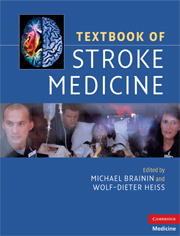Book contents
- Frontmatter
- Contents
- Preface
- List of contributors
- Section I Etiology, pathophysiology and imaging
- 1 Neuropathology and pathophysiology of stroke
- 2 Common causes of ischemic stroke
- 3 Neuroradiology
- 4 Ultrasound in acute ischemic stroke
- Section II Clinical epidemiology and risk factors
- Section III Diagnostics and syndromes
- Section IV Therapeutic strategies and neurorehabilitation
- Index
- References
1 - Neuropathology and pathophysiology of stroke
from Section I - Etiology, pathophysiology and imaging
Published online by Cambridge University Press: 05 May 2010
- Frontmatter
- Contents
- Preface
- List of contributors
- Section I Etiology, pathophysiology and imaging
- 1 Neuropathology and pathophysiology of stroke
- 2 Common causes of ischemic stroke
- 3 Neuroradiology
- 4 Ultrasound in acute ischemic stroke
- Section II Clinical epidemiology and risk factors
- Section III Diagnostics and syndromes
- Section IV Therapeutic strategies and neurorehabilitation
- Index
- References
Summary
The vascular origin of cerebrovascular disease
All cerebrovascular diseases (CVD) have their origin in the vessels supplying or draining the brain. Therefore, knowledge of pathological changes occurring in the vessels and in the blood is essential for understanding the pathophysiology of the various types of CVD and for the planning of efficient therapeutic strategies. Changes in the vessel wall lead to obstruction of blood flow, by interacting with blood constituents they may cause thrombosis and blockade of blood flow in this vessel. In addition to vascular stenosis or occlusion at the site of vascular changes, disruption of blood supply and consecutive infarcts can also be produced by emboli arising from vascular lesions situated proximally to otherwise healthy branches located more distal in the arterial tree or from a source located in the heart. At the site of occlusion, the opportunity exists for thrombus to develop in anterograde fashion throughout the length of the vessel, but this event seems to occur only rarely.
Changes in large arteries supplying the brain, including the aorta, are mainly caused by atherosclerosis. Middle-sized and intracerebral arteries can also be affected by acute or chronic vascular diseases of inflammatory origin due to subacute to chronic infections, e.g. tuberculosis and lues, or due to collagen disorders, e.g. giant cell arteriitis, granulomatous angiitis of the CNS, panarteritis nodosa, and even more rarely systemic lupus erythematosus, Takayasu's arteriitis, Wegener granulomatosis, rheumatoid arteriitis, Sjögren's syndrome, or Sneddon and Behcet's disease.
- Type
- Chapter
- Information
- Textbook of Stroke Medicine , pp. 1 - 27Publisher: Cambridge University PressPrint publication year: 2009
References
- 2
- Cited by

